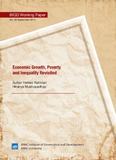| dc.description.abstract | The paper inspects the dynamics of economic growth, poverty and income inequality in different countries over time. The experience with economic growth and inequality show that both absolute and relative inequalities in expenditure/income have increased in several Asian countries over the last decade with the growth of the economy. Even though some level of poverty reduction was gained from economic growth, the growth is more advantageous for the rich in terms of education, occupation, nutrition, health and other public policies. This inequality has increased due – to the uneven growth in some sectors and some locations; the rapid increase in returns to higher education, skilled workers and employment; and the shift from a dominant socialist ideology to a more market-oriented economy. Inequality not only slows down the pace of poverty reduction for a given economic growth but also is a probable threat to sustainable economic growth. However, there are debates regarding the relationship between growth and inequality, especially on the form of the functional relationship between them. This paper tries to estimate this relationship without imposing any a-priori restriction on the functional relationship, and so the local polynomial (non-parametric) regression is employed. World Bank’s data on Gini index concerned with average index from 2003-2007 and annual percentage of the growth rate of GDP from 2008-2010 for 96 countries from Asia, Latin America, Africa and Europe were used to for this purpose. The non-parametric regression determines an inverted U-shaped relationship between inequality and growth, and the result is later confirmed by a cross-country parametric regression. So, the countries on the left side of the inverted-U curve, such as South Asian countries, have a positive relationship between inequality and growth, and vice-versa. The results show that rising income inequality in many Asian countries could be counterproductive for sustaining high growth, and outlines possible policy responses. | en_US |

